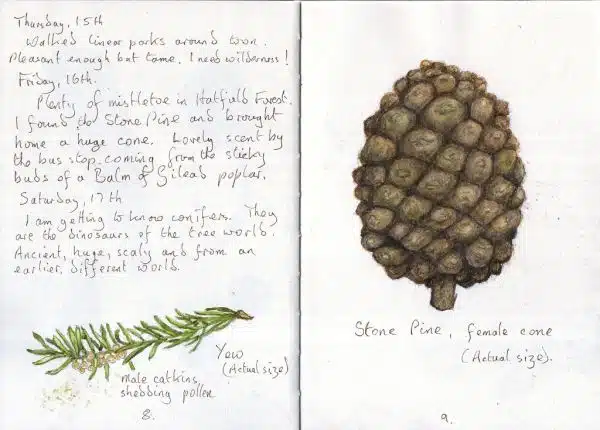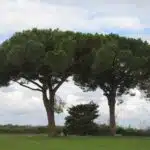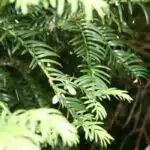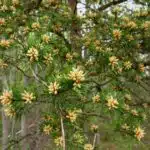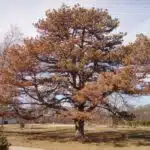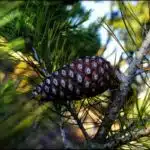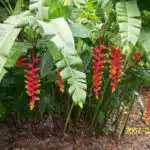Growing indoor plants is a popular way to add beauty and greenery to one’s living space. Among the various types of indoor plants, yew pine (Podocarpus macrophyllus) is a standout for its unique foliage and adaptability to indoor environments. As an indoor plant specialist, I have witnessed the increasing demand for yew pine as an attractive addition to homes and offices.
Yew pine is native to Japan and China, where it grows in forests as large trees up to 60 feet tall. However, it can be easily grown indoors as a compact shrub or tree with proper care. Its dark green, glossy leaves are long and narrow, resembling those of a pine tree. Yew pines are slow-growing but can live for decades if cared for correctly. In this article, we will explore the best ways to grow yew pine indoors and ensure that it thrives in your living space.
Yew Pine Plant Profile
Yew pine (Podocarpus macrophyllus) is a popular evergreen plant that can be grown indoors. It is native to China, Japan, and Korea and belongs to the Podocarpaceae family. This plant is known for its dark green foliage and upright growth habit, making it an attractive addition to any home or office space.
Yew pine is relatively easy to grow and care for indoors. It prefers bright, indirect light but can tolerate some shade. The soil should be well-draining and kept consistently moist, but not waterlogged. Yew pine also benefits from regular pruning to maintain its shape and promote healthy growth.
In terms of growth, yew pine can reach heights of up to 10 feet when grown outdoors in optimal conditions. However, when grown indoors, it typically reaches a more manageable height of around 4-6 feet. With proper care and maintenance, yew pine can live for many years as a beautiful addition to any indoor space.
Growing yew pine indoors has numerous benefits beyond just adding aesthetic appeal to your home or office space. In the following section, we will explore some of these benefits in more detail.
Benefits Of Growing Yew Pine Indoors
Growing yew pine indoors can provide numerous benefits for both your physical and mental health. This evergreen tree has lush green foliage that adds a touch of nature to any indoor space. In addition, it is known for its ability to improve air quality by purifying the air through its leaves.
Apart from enhancing the aesthetics of your indoor space, growing yew pine can also provide stress relief benefits. Research has shown that bringing natural elements into our homes and workplaces can have a positive impact on our mood and reduce stress levels. The presence of greenery can create a calming effect, which is especially beneficial in today’s fast-paced lifestyle.
To further illustrate the benefits of growing yew pine indoors, here are three ways this indoor plant can improve your overall well-being:
- It helps remove harmful toxins such as formaldehyde, benzene, and carbon monoxide from the air.
- It reduces stress levels by creating a relaxing environment.
- It increases humidity levels which can help alleviate respiratory issues.
Incorporating yew pine into your indoor plantscape not only enhances the beauty of your space but also contributes to improving your overall well-being. In the next section, we will discuss how to choose the right container and soil to ensure that your yew pine thrives in its new home.
Choosing The Right Container And Soil
Proper container drainage is crucial in cultivating a healthy yew pine plant indoors. A container that has no drainage holes will trap excess water, which can lead to root rot and other diseases. On the other hand, containers with too many drainage holes might dry out your plant too quickly. The ideal container should have enough drainage holes that allow water to flow freely, but not so many that it dries out the soil too quickly.
The pH level of soil is another important factor to consider when growing yew pine indoors. These plants prefer acidic soil, with a pH range between 4.5 to 6.0. If you’re using regular potting soil, mix it with peat moss, which has a low pH level and helps maintain acidity in the soil. Avoid using alkaline-rich soils like limestone or dolomite lime as it raises the pH level and makes the soil less acidic.
When selecting a container for your yew pine plant, choose one that’s big enough for its size but not too large that it hampers proper drainage. Similarly, ensure you use soil that’s well-draining, aerated and rich in nutrients while maintaining an optimal pH range of 4.5-6.0. By providing proper conditions for your plant, you can ensure healthy growth and avoid potential problems such as root rot and nutrient deficiencies.
Transition: Now that we’ve discussed the importance of choosing the right container and soil for your yew pine plants let’s move on to watering and humidity requirements necessary for their growth indoors.
Watering And Humidity Requirements
Watering is a crucial aspect of caring for yew pine plants. These plants require regular watering to thrive, especially during the growing season when they are actively producing new growth. However, overwatering can be detrimental to their health and may lead to root rot. Therefore, it is essential to strike a balance between providing enough water and avoiding excess.
The frequency of watering yew pine plants depends on several factors, including the size of the pot, the type of soil used, and environmental conditions. As a general guideline, it is best to wait until the top inch of soil feels dry before watering again. This ensures that the roots have access to moisture without being waterlogged. It is also important to avoid letting the soil completely dry out as this can cause stress and damage to the plant.
In addition to regular watering, misting techniques can also help maintain optimal humidity levels for yew pine plants. Misting involves spraying a fine mist of water onto the leaves and stems of the plant using a spray bottle or mister. This technique helps increase humidity levels around the plant, which is especially important in dry indoor environments. However, it’s important not to overdo it with misting since excessive moisture can lead to fungal growth or other issues.
Maintaining proper watering and humidity levels will ensure that your yew pine thrives indoors. In addition to these factors, light and temperature needs are also critical considerations for optimal growth and health.
Light And Temperature Needs
To ensure the proper growth and development of your indoor yew pine, it is important to provide adequate light and maintain an appropriate temperature range. The right conditions can make all the difference in the world when it comes to keeping your yew pine healthy and thriving.
When it comes to lighting, natural light is preferable for your yew pine. It should be placed near a window that receives bright but indirect sunlight. If natural light is not an option, artificial lighting can also be used. A full-spectrum grow light that mimics natural sunlight can be a good alternative.
Temperature range is also an important factor in maintaining the health of your yew pine. This plant prefers cooler temperatures between 50-70°F (10-21°C) year-round, so avoid placing it near heating or cooling vents. Be aware of seasonal changes as well; during winter months, make sure to keep your yew pine away from cold drafts or windows that are prone to frosting over.
To ensure optimal growth and thriving of your indoor yew pine, it’s essential to keep track of its light and temperature needs. By providing ample natural or artificial light and maintaining a temperature range between 50-70°F (10-21°C), you’ll set your plant up for success. In the next section, we’ll discuss how fertilizing can further support the health and longevity of your yew pine.
Fertilizing Your Yew Pine
Proper fertilization is essential in maintaining the health and growth of your yew pine plant. As an indoor plant specialist, I recommend using slow-release fertilizers, such as a 10-10-10 or 14-14-14 blend. These blends contain equal amounts of nitrogen, phosphorus, and potassium which are necessary for healthy foliage growth, root development, and overall plant vigor.
When it comes to frequency of fertilization, it’s important not to over-fertilize your yew pine. Over-fertilization can lead to burnt roots and stunted growth. As a general rule of thumb, fertilize your yew pine every two to three months during the growing season (spring through fall). During the winter months when growth slows down, reduce fertilizer application to once every four months.
Below is a table outlining some of the best fertilizers for yew pines along with their nutrient composition:
| Fertilizer | N-P-K Ratio |
|---|---|
| Osmocote Plus | 15-9-12 |
| Miracle-Gro Indoor Plant | 24-8-16 |
| Jobe’s Organics | 4-4-4 |
Incorporating these fertilizers into your routine will provide your yew pine with the necessary nutrients for optimal growth and development. In the next section, we’ll discuss how to prune and shape your plant for maximum aesthetic appeal.
Pruning And Shaping Your Plant
- Pruning techniques should be tailored to the individual needs of each plant, taking into account factors such as the age and size of the plant, as well as its intended purpose.
- Tools and supplies necessary for pruning yew pine (Podocarpus macrophyllus) indoors include sharp garden shears, pruning saws, and protective gloves.
- Regular fertilizing and watering can help create an ideal environment for yew pines to flourish indoors.
- Pruning should be done in the spring and summer months to help encourage new growth and reduce the risk of disease.
- Fertilizer should be applied in moderation to avoid over-fertilizing which can lead to nutrient deficiencies or toxicity in the plant.
- Watering should be done at regular intervals to ensure the soil stays moist, but not soggy, and to avoid stressing the plant.
Pruning Techniques
Pruning is an essential aspect of growing yew pine indoors. This technique helps to maintain the health and shape of the plant, ensuring it grows well in its confined space. Pruning frequency depends on how fast the plant grows, but it is recommended to prune yew pine at least once a year. Pruning involves cutting off dead or diseased branches, leaves or twigs that may be hindering the growth of new ones.
Shaping techniques are also crucial when pruning yew pine. The goal is to create a pleasing aesthetic while maintaining good health. One popular shaping technique for yew pines indoors is topiary, which involves shaping the plant into geometric forms like spheres, cones or cylinders. Another technique is espalier, which involves pruning and training the branches to grow horizontally along a wall or trellis.
In conclusion, pruning and shaping your yew pine indoor plant requires careful attention and patience. You need to know when to prune and how often, as well as understanding which shaping techniques work best for your plant’s specific needs. By following these guidelines, you can help your yew pine thrive indoors while also creating an attractive addition to your home décor.
Tools & Supplies
Indoor gardening requires essential tools and supplies to maintain the health and aesthetics of your plants. When pruning and shaping your yew pine indoor plant, you need to have the right equipment to ensure that you achieve a desirable outcome. The basic tools you will need are pruning shears, scissors, gloves, and a container for the trimmed branches.
Pruning shears are essential when cutting off thick branches or twigs that may be hindering new growth. Scissors are ideal for trimming leaves or small twigs from your yew pine plant. Gloves protect your hands from being scratched by the needles of the yew pine while handling it during pruning. Lastly, a container is important as it keeps all trimmed parts in one place, making it easy to dispose of them later.
When choosing tools and supplies for indoor gardening, it’s important to consider quality over price. Investing in high-quality equipment ensures that they last longer and can handle more challenging tasks effectively. A good-quality set of pruning shears can last for years with proper maintenance, which saves you money in the long run.
In summary, having the right tools and supplies when pruning and shaping your yew pine indoor plant is crucial for its well-being. Investing in high-quality equipment not only lasts longer but also ensures better results compared to using substandard products. By acquiring these essential items for container gardening, you can create an aesthetically pleasing and healthy environment for your yew pine indoor plant.
Fertilizing & Watering
After pruning and shaping your yew pine indoor plant, it’s crucial to consider fertilizing and watering it properly. These are essential practices that can help maintain the health and growth of your plant. Best practices for fertilizing include using organic fertilizers as they provide nutrients that are slowly released into the soil, promoting healthy root development. On the other hand, synthetic fertilizers offer a quick nutrient boost but may lead to chemical damage if not used correctly.
Watering your yew pine indoor plant requires careful consideration, as overwatering or underwatering can be detrimental to its health. Common mistakes made in watering include not allowing enough drainage or watering too frequently, which can lead to root rot. It’s best to water your plant when the soil is dry 1-2 inches below the surface, ensuring that the roots have access to moisture without drowning them.
Organic vs synthetic fertilizers are also an important consideration when maintaining your yew pine indoor plant. While organic fertilizers are more sustainable and environmentally friendly, they take longer to release nutrients compared to synthetic ones. However, synthetic fertilizers may contain chemicals harmful to the environment and can cause rapid growth that weakens plants over time.
In conclusion, proper fertilizing and watering practices are crucial for maintaining a healthy yew pine indoor plant. Best practices involve using organic fertilizers and avoiding common mistakes such as overwatering or using synthetic fertilizers excessively. By incorporating these practices into your routine care for your yew pine indoor plant, you can ensure its longevity and beauty within your home or office space.
Propagating Yew Pine
The propagation of a yew pine (podocarpus macrophyllus) is both an art and science. There is a theory that suggests that the best time to propagate a yew pine is during the spring season. However, this theory only holds true if you are planning to use cuttings as your propagation method. In fact, yew pines can be propagated all year round using different techniques.
One of the most common yew pine propagation techniques is through stem cuttings. This technique involves taking a cutting from the plant’s stem and rooting it in soil or water until it grows roots and shoots. The best time to do this is during the early spring season when new growth appears on the plant. Another propagation technique is through layering, which involves bending a lower branch of the plant onto the soil and making it grow roots while still attached to the parent plant.
While spring may be considered as the best propagation season for yew pines, one should not limit themselves to this timeframe alone. There are other methods of propagating these plants such as air-layering and grafting that can be done throughout the year. It’s important to keep in mind that selecting healthy parent plants and providing ideal growing conditions such as proper light exposure, moisture levels, and temperature are crucial for successful propagation. In the next section, we will discuss common pests and diseases that affect yew pines and how to prevent them from causing damage to your indoor garden.
Common Pests And Diseases
After successfully propagating your yew pine, it’s time to focus on its growth and maintenance. Yew pines are versatile plants that can thrive both indoors and outdoors. However, growing them indoors requires extra attention to their specific needs.
Preventive measures are essential in keeping your indoor yew pine healthy. Make sure to place it in a bright location with indirect sunlight and away from drafts. Keep the soil moist but not waterlogged, as yew pines are sensitive to overwatering. In addition, ensure proper drainage by using well-draining soil and pots with drainage holes.
Organic solutions can be used when dealing with common pests and diseases of yew pines. Spider mites and scale insects are potential problems that can be prevented by regularly wiping down the leaves with a damp cloth or spraying them with neem oil. If you notice yellowing leaves or brown spots, this may indicate a fungal infection. To treat this issue, remove any affected leaves and improve air circulation around the plant.
Next, we will discuss troubleshooting common issues that may arise during the growth of your indoor yew pine. It is important to address these problems promptly to prevent further damage to the plant’s health. By following these preventive measures and organic solutions, you can ensure a thriving yew pine in your indoor space.
Troubleshooting Common Issues
Growing yew pine indoors can be a challenging task, even for experienced indoor plant enthusiasts. One common issue that many people encounter is pests. Mealybugs, spider mites, and scale insects are some of the most common pests that can attack yew pines. To prevent these pests from taking over your plant, it is crucial to keep them clean and free from dust and debris. Regularly wiping down the leaves with a damp cloth or spraying them with neem oil or insecticidal soap can help eliminate any pests that may have taken up residence.
Another issue that many people face when growing yew pine indoors is soil pH levels. Yew pines prefer acidic soil with a pH range between 5.0 and 6.5. If the soil pH level is too high or too low, it can cause issues such as yellowing leaves, stunted growth, and even death in extreme cases. To prevent this from happening, it is important to test the soil regularly using a pH meter or testing kit. If the pH level is out of range, you can adjust it by adding amendments such as sulfur or lime to bring it back into the preferred range.
To ensure your yew pine thrives indoors, pest prevention and maintaining proper soil pH levels are essential factors to consider. Here’s a table summarizing some tips to help you troubleshoot common issues:
| Issue | Cause | Solution |
|---|---|---|
| Pests | Poor hygiene | Regularly wipe down leaves with a damp cloth or spray them with neem oil or insecticidal soap |
| Soil pH levels | Imbalanced acidity | Test soil regularly and adjust using amendments like sulfur or lime |
By following these tips and being vigilant in monitoring your plant’s health, you can enjoy growing a beautiful yew pine indoors for years to come!
Conclusion
In conclusion, growing yew pine indoors can bring a touch of elegance and tranquility to any living space. The plant’s glossy green leaves and compact form make it an ideal choice for those who desire a low-maintenance yet visually striking houseplant. The benefits of growing yew pine indoors are numerous, from improving air quality to reducing stress levels.
However, successful indoor cultivation of yew pine requires proper care and attention. Choosing the right container and soil, providing adequate water and humidity, as well as providing sufficient light and temperature are all vital factors in keeping your plant healthy and thriving. Regular pruning and shaping will help maintain its shape and promote new growth.
While pests and diseases may pose a threat to your plant, proper monitoring and treatment can prevent their spread. With these tips in mind, you can enjoy the beauty of yew pine in your home or office for years to come. As an indoor plant specialist, I highly recommend incorporating this stunning plant into your indoor garden collection – it is sure to bring joy to all who encounter it!
Image Credits
- “Yew and Stone Pine” by Hornbeam Arts (featured)

